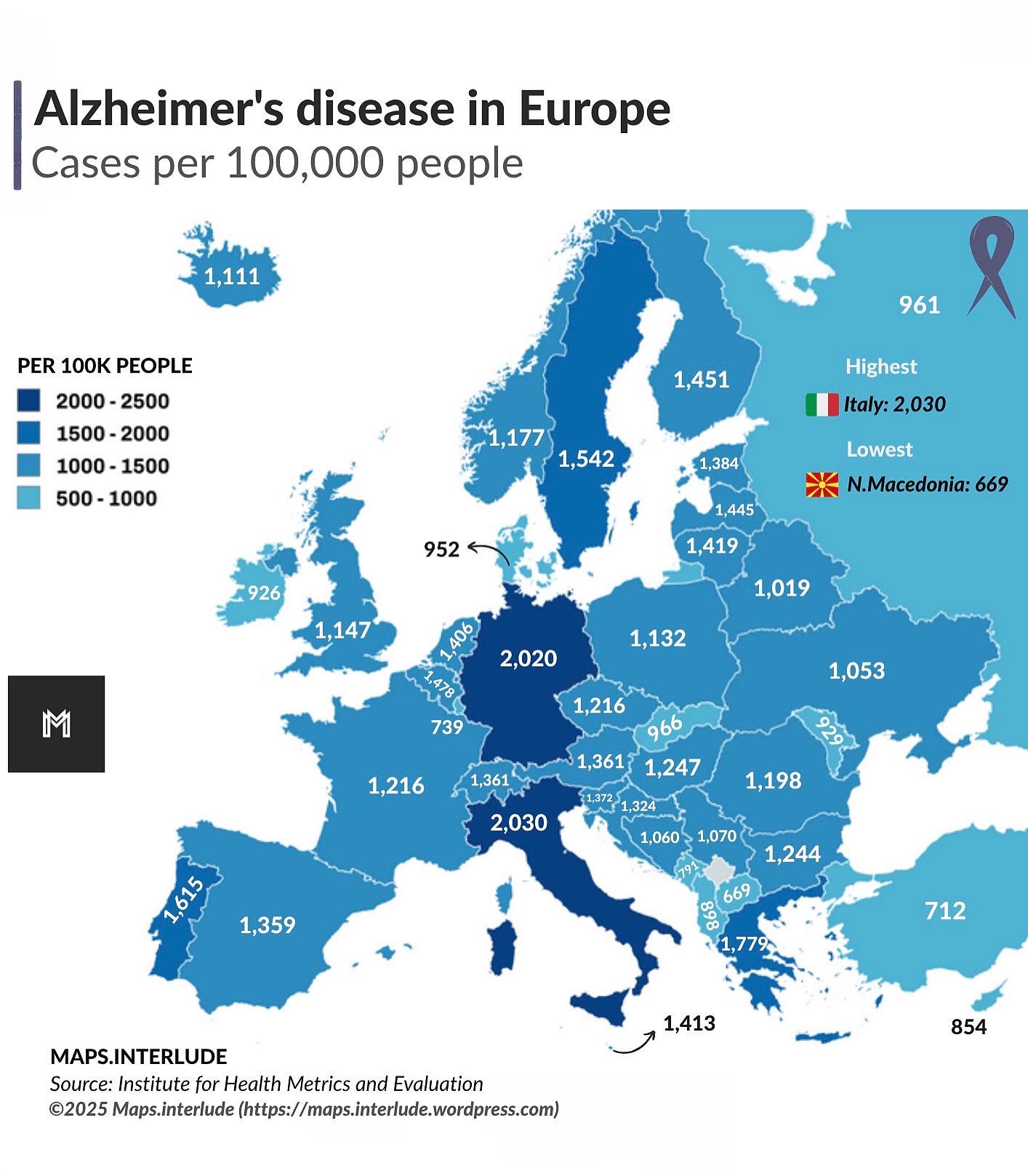Alzheimer’s Disease Prevalence Map in Europe


Marcus Rodriguez
Historical Geography Expert
Marcus Rodriguez specializes in historical cartography and geographic data analysis. With a background in both history and geography, he brings unique...
Geographic Analysis
What This Map Shows
The "Alzheimer’s Disease Prevalence Map in Europe" provides a visual representation of the distribution of Alzheimer’s disease across various countries in Europe. This map highlights the percentage of the population affected by this neurodegenerative disorder, offering insights into how widespread the disease is regionally. It serves as a crucial tool for understanding not only the impact of Alzheimer’s on different populations but also the healthcare challenges that come with it.
Deep Dive into Alzheimer’s Disease
Alzheimer's disease is a progressive neurological disorder that primarily affects older adults, leading to memory loss, cognitive decline, and ultimately the inability to carry out daily activities. According to the World Health Organization, Alzheimer’s is the most common cause of dementia, accounting for 60-70% of cases. The disease has significant implications for individuals, families, and health care systems alike.
Interestingly, the prevalence of Alzheimer’s varies significantly across Europe, influenced by factors such as age demographics, lifestyle, and genetic predispositions. For example, countries with older populations, such as Italy and Germany, report higher prevalence rates, often exceeding 10% in those aged 65 and older. In contrast, Eastern European countries tend to have lower reported rates, possibly due to underdiagnosis or differences in healthcare access and awareness.
Moreover, the incidence of Alzheimer’s is projected to rise dramatically in the coming decades as the European population ages. The European Commission has estimated that by 2050, the number of people living with dementia in Europe will reach 14 million, doubling the current figures. This stark projection underscores the urgent need for better understanding, treatment, and care strategies for Alzheimer’s.
Research indicates that several risk factors contribute to the development of Alzheimer’s disease, including genetics, lifestyle choices, and environmental influences. For instance, a diet high in saturated fats and low in antioxidants has been linked to increased risk, while regular physical activity and cognitive engagement may offer protective benefits. This intersection of lifestyle and health highlights the importance of preventive strategies in managing Alzheimer’s risk.
Regional Analysis
When examining the Alzheimer’s disease prevalence across Europe, distinct patterns emerge. Western Europe, particularly countries like France, the Netherlands, and the UK, shows a higher incidence of Alzheimer’s among the elderly population. This could be attributed to advanced diagnostic practices and higher awareness levels, leading to more cases being reported. For instance, France has one of the highest dementia rates in Europe, with estimates suggesting around 1.2 million individuals living with Alzheimer’s.
In contrast, Eastern Europe presents a different picture. Countries like Poland and Romania report lower prevalence rates, which may reflect not only demographic differences but also disparities in healthcare infrastructure. For example, access to neurological services and diagnostic tools varies significantly, potentially leading to underreported cases. Interestingly, the cultural attitudes towards aging and dementia in these regions might also contribute to a lack of awareness and earlier intervention.
Southern European nations, such as Spain and Italy, often report a mix of high prevalence rates due to aging populations but also show significant regional differences within the countries. Urban areas tend to have higher reported rates, likely due to better healthcare access, whereas rural areas may suffer from lower awareness and fewer resources. For instance, in Italy, regions like Lombardy have higher reported cases compared to the less populated areas of the south.
Significance and Impact
Understanding Alzheimer’s disease prevalence in Europe is crucial for several reasons. As the population ages, the burden on healthcare systems will increase, necessitating a focus on effective care models and support systems. Policymakers and healthcare providers must prepare for the increasing demand for dementia care, which includes not only medical treatment but also support for families and caregivers.
Moreover, this map serves as a wake-up call for public health initiatives aimed at raising awareness and encouraging early diagnosis and intervention. Public campaigns can play a vital role in educating communities about Alzheimer’s, helping to reduce stigma and promoting healthier lifestyles that may mitigate risk. Interestingly, research is also exploring the potential impact of social determinants of health on Alzheimer’s prevalence, suggesting that socioeconomic factors play a critical role in both risk and access to care.
In conclusion, the Alzheimer’s disease prevalence map in Europe not only showcases the current landscape of this debilitating disorder but also highlights an impending public health challenge. As we look towards the future, addressing the complexities surrounding Alzheimer’s will be essential for improving outcomes and enhancing the quality of life for millions of individuals affected by this disease.
Visualization Details
- Published
- October 7, 2025
- Views
- 52
Comments
Loading comments...